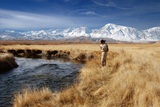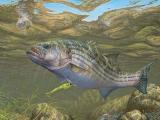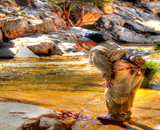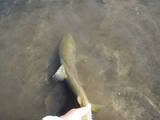REALTIME FLOWS  U. Kern: n/a cfs
U. Kern: n/a cfs
 L. Kern: 1341 cfs
L. Kern: 1341 cfs
 E.W: 312 cfs
E.W: 312 cfs
 U. Owens: 108 cfs
U. Owens: 108 cfs  L. Owens: 496 cfs 09/02/19 1:15 PM PST
L. Owens: 496 cfs 09/02/19 1:15 PM PST
Something to think about next time your releasing a fish!
23 posts
• Page 1 of 2 • 1, 2
Something to think about next time your releasing a fish!
I read this article in another newsletter and thought it was interesting.
Mark
One of the joys of living in California is that we can
and do fish throughout the year. But this benefit
includes a burden. For the last few years, I have
been reminding people on our winter fishing trips,
especially the January and February trips to the Lower
Owens for the new anglers, that removing fish from
the water to remove the hook or to take photographs
can be hazardous to fish. The reason I gave is that
the water is often warmer than the air temperature
and sometimes the gill filaments will freeze instantly
when the fish is lifted from its native environment. A
frozen gill filament is irreparably destroyed.
I’ve often heard anglers say when photographing
their trophy to hold your breath while you have the
fish out of water to appreciate its predicament. The
problem, as I see it anyway, is that when you tell some
one to hold his breath, he will inhale to be sure he has
an ample supply. But I know that when I fell out of
the boat on the Bighorn, I did not have the presence
of mind to inhale on the way into the water. Rather
I was in a state of shock that the boat was no longer
underneath me.
I would imagine a fish that is rapidly changing
from water to air is similarly challenged. Besides, he
can’t store oxygen with a big gulp of water.
I don’t recall where I read about the frozen gill
problem but it made sense to me. Recently, an article
appeared in the winter 2010 edition of Flyfishing
& Tying Journal entitled “Fish Out of Water”. The
author is an angler, photographer and biologist. The
genesis of the article was his observation that the
number of states is growing which now require that
fish to be released, must remain in the water.
We practice Catch and Release Fishing as a method
of preserving the fishing enjoyment for others and
for future generations. But the author was driven by
the question “What science is available to support the
new regulations?” While he notes there is a paucity of
scientific literature, initial studies are quite revealing
and of deep concern.
In one study, Brook trout were chased by hand for 30
seconds in 50 degree water. Then they were subjected
to swimming stress tests to measure their ability to
swim after being removed from the water for 0, 30,
60 and 120seconds. While the fish that was kept out
of the water for 30 and 60 seconds performed about
as well as the control fish (which were not subjected
to air), the fish that were kept out of water for 120
seconds failed to swim at all. Since this was not a
mortality study, the researchers did not determine
how well the 30 and 60 seconds fish swam or whether
they could have escaped their natural predators.
A mortality study performed on Rainbow trout
provided some insight. All fish exposed to the air
experienced a drop in oxygen levels to 20% of the
control group. The results changed with vigorous
exercise (read “playing the fish”). The survival rate
of fish not exposed to air after exercise dropped to
88%.
But fish out of water for 30 or 60 seconds (after exercise)
survived 62% and 28% of the time, respectively. And
all the fish exposed to air experienced some adhesion
of the gill filaments and inhibited gas exchange. Not
just frozen gill filaments!
Another study that was performed on Rainbows
exposed the trout to exercise and then electroshock
after which the researchers would keep the trout out
of water from 0 to 4 minutes. The bottom line of this
study is that the decreased swimming function lasted
from one to six hours. Enter the fish hawks!
While lamenting the absence of a significant body
of empirical experimentation and data, the author
clearly is concerned that a fish out of water will
be stressed both biochemically and in its future
performance regardless of the time involved. These
studies were all performed at 50 degree water.
Water higher in temperature loses its ability to hold
dissolved oxygen. So these limited results are not
transferable there. Similarly, larger fish have a greater
need for oxygen; the suggestion is made not to
remove the head from water at all. And maybe there
is a difference between the survivability of hatchery
trout and wild natives. Since even a small exposure to air (especially in Los
Angeles) is detrimental, it behooves us to keep our
finned friends in the water as much as possible.
For the novices, this means that your fly rod must
be suitable for your target fish because you must
get your trophy under control and spend the least
amount of time playing or fighting your fish. The use
of barbless hooks will make easy work of removing
the fly while the fish is still in the water.
But keep your forceps handy. You want your fish to
have good memories of being caught so that it will
readily take a fly in the future!.
Mark
One of the joys of living in California is that we can
and do fish throughout the year. But this benefit
includes a burden. For the last few years, I have
been reminding people on our winter fishing trips,
especially the January and February trips to the Lower
Owens for the new anglers, that removing fish from
the water to remove the hook or to take photographs
can be hazardous to fish. The reason I gave is that
the water is often warmer than the air temperature
and sometimes the gill filaments will freeze instantly
when the fish is lifted from its native environment. A
frozen gill filament is irreparably destroyed.
I’ve often heard anglers say when photographing
their trophy to hold your breath while you have the
fish out of water to appreciate its predicament. The
problem, as I see it anyway, is that when you tell some
one to hold his breath, he will inhale to be sure he has
an ample supply. But I know that when I fell out of
the boat on the Bighorn, I did not have the presence
of mind to inhale on the way into the water. Rather
I was in a state of shock that the boat was no longer
underneath me.
I would imagine a fish that is rapidly changing
from water to air is similarly challenged. Besides, he
can’t store oxygen with a big gulp of water.
I don’t recall where I read about the frozen gill
problem but it made sense to me. Recently, an article
appeared in the winter 2010 edition of Flyfishing
& Tying Journal entitled “Fish Out of Water”. The
author is an angler, photographer and biologist. The
genesis of the article was his observation that the
number of states is growing which now require that
fish to be released, must remain in the water.
We practice Catch and Release Fishing as a method
of preserving the fishing enjoyment for others and
for future generations. But the author was driven by
the question “What science is available to support the
new regulations?” While he notes there is a paucity of
scientific literature, initial studies are quite revealing
and of deep concern.
In one study, Brook trout were chased by hand for 30
seconds in 50 degree water. Then they were subjected
to swimming stress tests to measure their ability to
swim after being removed from the water for 0, 30,
60 and 120seconds. While the fish that was kept out
of the water for 30 and 60 seconds performed about
as well as the control fish (which were not subjected
to air), the fish that were kept out of water for 120
seconds failed to swim at all. Since this was not a
mortality study, the researchers did not determine
how well the 30 and 60 seconds fish swam or whether
they could have escaped their natural predators.
A mortality study performed on Rainbow trout
provided some insight. All fish exposed to the air
experienced a drop in oxygen levels to 20% of the
control group. The results changed with vigorous
exercise (read “playing the fish”). The survival rate
of fish not exposed to air after exercise dropped to
88%.
But fish out of water for 30 or 60 seconds (after exercise)
survived 62% and 28% of the time, respectively. And
all the fish exposed to air experienced some adhesion
of the gill filaments and inhibited gas exchange. Not
just frozen gill filaments!
Another study that was performed on Rainbows
exposed the trout to exercise and then electroshock
after which the researchers would keep the trout out
of water from 0 to 4 minutes. The bottom line of this
study is that the decreased swimming function lasted
from one to six hours. Enter the fish hawks!
While lamenting the absence of a significant body
of empirical experimentation and data, the author
clearly is concerned that a fish out of water will
be stressed both biochemically and in its future
performance regardless of the time involved. These
studies were all performed at 50 degree water.
Water higher in temperature loses its ability to hold
dissolved oxygen. So these limited results are not
transferable there. Similarly, larger fish have a greater
need for oxygen; the suggestion is made not to
remove the head from water at all. And maybe there
is a difference between the survivability of hatchery
trout and wild natives. Since even a small exposure to air (especially in Los
Angeles) is detrimental, it behooves us to keep our
finned friends in the water as much as possible.
For the novices, this means that your fly rod must
be suitable for your target fish because you must
get your trophy under control and spend the least
amount of time playing or fighting your fish. The use
of barbless hooks will make easy work of removing
the fly while the fish is still in the water.
But keep your forceps handy. You want your fish to
have good memories of being caught so that it will
readily take a fly in the future!.
Make Fly Fishing Great Again!
-

fly addict - Posts: 2560
- Joined: August 3rd, 2008, 1:57 pm
- Location: In your honey hole!
Re: Something to think about next time your releasing a fish!
Wow! Thanks for all that info. If you have any other C&R/mortality stats you can point me to, I would very much appreciate it.
briansII
briansII
-

briansII - Posts: 4902
- Joined: September 3rd, 2008, 12:39 pm
- Location: Central Ca.
Re: Something to think about next time your releasing a fish!
I've often wondered about the relationship of the outside air temps and handling fish for photos. I only wish we could get people to feel that photographing your fish lying next to your fishing rod on the ground/gravel/grass/snow is not artistic or cool. It grates on me like fingernails slowly screeching on a blackboard.
"Tomorrow is the most important thing in life. Comes into us at midnight very clean. It's perfect when it arrives and it puts itself in our hands. It hopes we've learnt something from yesterday."
John Wayne
John Wayne
-

Wildman - Site Admin
- Posts: 3747
- Joined: August 17th, 2008, 2:07 pm
Re: Something to think about next time your releasing a fish!
Something to keep in mind for all you guys heading up to the Owen's this weekend.
Eric
Eric
-

Eric - Posts: 2430
- Joined: August 18th, 2008, 3:01 pm
- Location: Mission Hills, Ca
Re: Something to think about next time your releasing a fish!
Some really great advise for all the grip and grin shots, bottom line is not to remove the fish from the water, I have been guilty of this many a times. The barbless hooks are a no brainer, those that don't debarb have seen what the hook does to the fishes mouth 
Thanks for sharing this

Thanks for sharing this
- Benny
- Posts: 3328
- Joined: July 28th, 2008, 11:11 pm
Re: Something to think about next time your releasing a fish!
When it's really Cold, i just grab the leader and wiggle the barbless fly out.. I do not want to get my Hands wet and have them Freeze....
This is a Great Post that Everyone here should read and take to heart....
This is a Great Post that Everyone here should read and take to heart....

"...I became Insane, with long intervals of Horrible Sanity..." ~ Edgar Allan Poe
-

Flyjunkie - Posts: 1455
- Joined: February 4th, 2008, 8:06 pm
- Location: Chumash Country
Re: Something to think about next time your releasing a fish!
If you want to take a picture of a fish... keep it in the net and in the water until you're ready to shoot... then lift, snap, release. the 30 seconds they are mentioning seems like a * of a long time to be manhandling a fish out of water. 60 seconds seems like an eternity.
Good info though... but I hate un-cited sources. I wanna look at the studies first hand.
Good info though... but I hate un-cited sources. I wanna look at the studies first hand.
Fishing is the most wonderful thing I do in my life, barring some equally delightful unmentionables.
http://www.adiposefin.com
http://www.adiposefin.com
-

rayfound - Posts: 2401
- Joined: September 11th, 2008, 11:11 pm
- Location: Riverside, ca
Re: Something to think about next time your releasing a fish!
Lately I take more pictures with the fish in the net, or keep it in the water, and barely lift it out to take a picture. I knew a group years ago, that broke the point off their hooks, and considered a take good enough. I firmly believe that most fly fisherman try to respect the resources (fish, rivers, banks, etc), and are responsible as a group.
Set the hook!


-

beachbum - Posts: 3616
- Joined: December 3rd, 2008, 2:54 pm
- Location: Camarillo, CA
Re: Something to think about next time your releasing a fish!
"For the novices, this means that your fly rod must
be suitable for your target fish because you must
get your trophy under control and spend the least
amount of time playing or fighting your fish".
Those that fish with me have heard my rant about this before.
 The chest pounding around the camp fire at the end of the day is fun, but at what cost. The loss of a trophy fish, doesn't seem worth it to me. Bring the right rod for the job.
The chest pounding around the camp fire at the end of the day is fun, but at what cost. The loss of a trophy fish, doesn't seem worth it to me. Bring the right rod for the job.
Beachbum; I fish with pointless flies quite often, it's fun. When my local water is too warm and I don't want to stress fish I spend alot of afternoons throwing pointless flies to little wild fish. A couple weeks ago after a cancelled trip up North with Norcalbob, I hit the local tailwater. I had a couple different new patterns that I wanted to try out on the sippers. I spent 4 hours throwing to a surface feeding pod of fish, with pointless flies. Ended the session with 11 solid takes, 7 on one pattern and 4 on the other. The cool thing about the pointless flies is that you don't put the feeders down after a take, as you would if you hooked and had to fight a fish. I was able to recast to the risers without having to wait for them to start feeding again. Sometimes getting the perfect drift with the perfect fly and seeing the take is all I need.
Randy
be suitable for your target fish because you must
get your trophy under control and spend the least
amount of time playing or fighting your fish".
Those that fish with me have heard my rant about this before.
Beachbum; I fish with pointless flies quite often, it's fun. When my local water is too warm and I don't want to stress fish I spend alot of afternoons throwing pointless flies to little wild fish. A couple weeks ago after a cancelled trip up North with Norcalbob, I hit the local tailwater. I had a couple different new patterns that I wanted to try out on the sippers. I spent 4 hours throwing to a surface feeding pod of fish, with pointless flies. Ended the session with 11 solid takes, 7 on one pattern and 4 on the other. The cool thing about the pointless flies is that you don't put the feeders down after a take, as you would if you hooked and had to fight a fish. I was able to recast to the risers without having to wait for them to start feeding again. Sometimes getting the perfect drift with the perfect fly and seeing the take is all I need.

Randy
Always looking for brownie points
-

Rollincast - Posts: 193
- Joined: July 25th, 2008, 9:50 am
- Location: Strathmore, CA
Re: Something to think about next time your releasing a fish!
RC, it doesn't surprise me you do that. I do a lot of intentional long line releasing, after getting the take.
Your point about the right rod is well taken here. I know the 0 wts have a place on the little streams, but I wonder about the wisdom of trying to play a big fish, on an ultra soft rod, in big water. I know it's a touchy subject, but since you brought it up...
BB
Your point about the right rod is well taken here. I know the 0 wts have a place on the little streams, but I wonder about the wisdom of trying to play a big fish, on an ultra soft rod, in big water. I know it's a touchy subject, but since you brought it up...
BB
Set the hook!


-

beachbum - Posts: 3616
- Joined: December 3rd, 2008, 2:54 pm
- Location: Camarillo, CA
Re: Something to think about next time your releasing a fish!
Excellent read, I have been guilty of holding a fish or two out of water for a little too long in the past, but I have always done my best to cradle the fish in running water until it swims away. Guess its time to take pics of the fish in the net.
Sean
Sean
- tree catcher
- Posts: 339
- Joined: October 5th, 2009, 9:48 pm
Re: Something to think about next time your releasing a fish!
beachbum wrote:RC, it doesn't surprise me you do that. I do a lot of intentional long line releasing, after getting the take.
Your point about the right rod is well taken here. I know the 0 wts have a place on the little streams, but I wonder about the wisdom of trying to play a big fish, on an ultra soft rod, in big water. I know it's a touchy subject, but since you brought it up...
BB
Depends on ones ability. I have been blasted on other forums for fishing my 0 on some waters. The bottom line is that I am able to control the fish and land them quickly despite the fact I am fishing a 0. I did an experiment and timed the fight time with my 5 and my 000 on a river with browns. On both rods the time to net was averaged out to < 1 min when using 4x.
Bottom line is if you over play a fish no matter what the rod size is you stand a greater chance of killing it.
-

Sasha - Posts: 3885
- Joined: July 11th, 2008, 10:42 pm
- Location: The 208
Re: Something to think about next time your releasing a fish!
DrCreek wrote:Sasha wrote:
Depends on ones ability. ...Bottom line is if you over play a fish no matter what the rod size is you stand a greater chance of killing it.
Nice... and very smoothly stated, Sasha. But prepare for the onslaught from those who will take that personally, you 0wt clown !!
Oh I am not worried, and I stand by what I wrote. Plus I never really get all bothered by the internet commandos
Am I going to fish my 0 for steelhead or real big fish, no. But for those browns in that river and the bows on my other winter tailwater spot I am not too concerned about fishing a 0. Plus if I fight starts to go south, one can always aim the rod at the fish and let it go.
Now I have seen people post reports that make the fish I catch look like minnows and they have done it with 2wt and lighter rods. But hey to each their own....... If one does not feel comfortable fishing anything lighter than a 5wt I sure won't tell them otherwise as it is not my business......
-

Sasha - Posts: 3885
- Joined: July 11th, 2008, 10:42 pm
- Location: The 208
Re: Something to think about next time your releasing a fish!
I'll just leave this here http://ultralightflyfishing.yuku.com/to ... tches.html
The carp on the TXL must have been fun......
The carp on the TXL must have been fun......
-

Sasha - Posts: 3885
- Joined: July 11th, 2008, 10:42 pm
- Location: The 208
Re: Something to think about next time your releasing a fish!
No commando tactics here, and it's why I put the disclaimer. To be able to discuss sensitive issues, is one of the many reasons we are here on this board. There are always a few sacred cow issues, and that's one of them. As for a few of the others, we have beat them to death already.  Please don't take my comments as an attack, but take them as things that are part of that discussion.
Please don't take my comments as an attack, but take them as things that are part of that discussion.
Bill
 Please don't take my comments as an attack, but take them as things that are part of that discussion.
Please don't take my comments as an attack, but take them as things that are part of that discussion.Bill
Set the hook!


-

beachbum - Posts: 3616
- Joined: December 3rd, 2008, 2:54 pm
- Location: Camarillo, CA
23 posts
• Page 1 of 2 • 1, 2
Who is online
Users browsing this forum: No registered users and 162 guests

